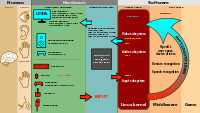Black box (systems theory)
In cybernetics and systems theory, a black box is a (possibly very complex ) system of which only the external behavior is to be considered in the given context. The internal structure may be known; However, such knowledge may not be used (e.g. because a successor model may be built differently inside). The investigation and description is limited to measuring the input-output relationships (EVA principle) .
Unlike a closed system in thermodynamics , such a system can also exchange matter with the environment, for example a ticket machine .
The opposite of a black box is usually a white box ( Engl. White box ) called; metaphorically consistent terms Glass Box and Clear Box ( Engl. glass box or clear box ) are synonymous, but are used less frequently.
Word origin
The term Black Box ( Engl. Black box ) is originally from the military telecommunications and called captured enemy equipment, which could not be opened because of it may contain explosives.
Overview
In general, a black box is an object whose internal structure and internal functioning are unknown or are not considered to be important. Rather, it is only the behavior of the black box that is of interest , which ensures a certain functionality via defined interfaces . The motivation in using the term tends to be the inside not interested (now) , even if it is sometimes not used in the sense of we know it (anyway) . This approach is often used to reduce the complexity of the object of observation. The deliberate omission of detailed information (depth information) is also referred to as the principle of secrecy . This gives the system operator an energetic advantage that he can use for other (theoretical and practical) matters.
- "The only conceivable way of unveiling a black box, is to play with it" ( "The only conceivable way to uncover the inside of a black box is to play with it ." ) René Thom , Mathematical Models , p. 298.
In systems theory , the black box approach is used methodically, in that only the relationship between stimulus or input and reaction or output is analyzed to analyze system behavior . Causality is not a prerequisite, but a simplifying assumption. Ideally, the mathematical description of these relationships allows conclusions to be drawn about the substrate and the type of interconnection of the signals within the system.
application

The typical form of the black box model is modularization .
This method is successfully applied to electronic circuits , neural systems or individual neurons . Signal forms that are easy to analyze analytically, such as B. selected sinusoidal signals. As an intermediate stage of the analysis, so-called equivalent circuit diagrams are constructed in which various electronic filters are interconnected according to the system behavior. The method is also used in numerous numerical-mathematical processes.
Data encapsulation in programming and the black box test in software development are methods of software development.
From the point of view of organizational responsibility, we speak of a black box to make it clear, for example, that a maintenance technician is not responsible for certain internal functions of a component - in the event of failure, it should only be replaced as a whole.
When modeling a mathematical model , we speak of a black box if the internal behavior of a system is not to be taken into account in the modeling, but only the reaction of a system is described in a mathematical formula.
literature
- Rene Thom: Mathematical Models of Morphogenesis. Chichester: Ellis Horwood 1984. ISBN 0-13-561515-1
- Niklas Luhmann: Social Systems. Outline of a general theory. Frankfurt am Main: Suhrkamp, 12th edition 2006. ISBN 3-518-28266-2
